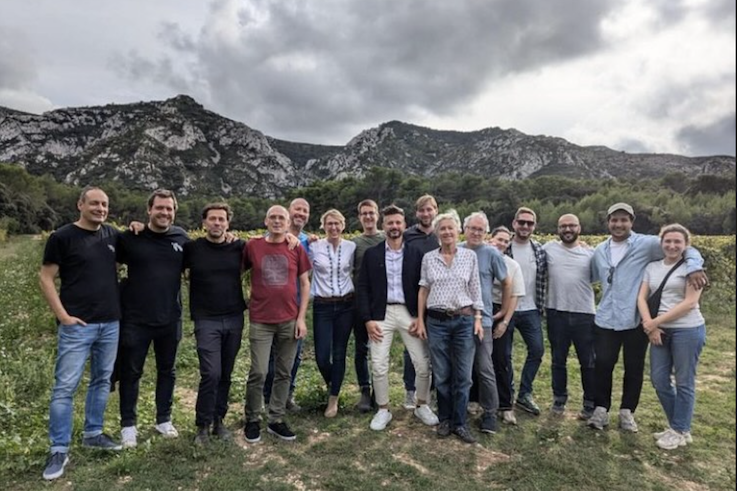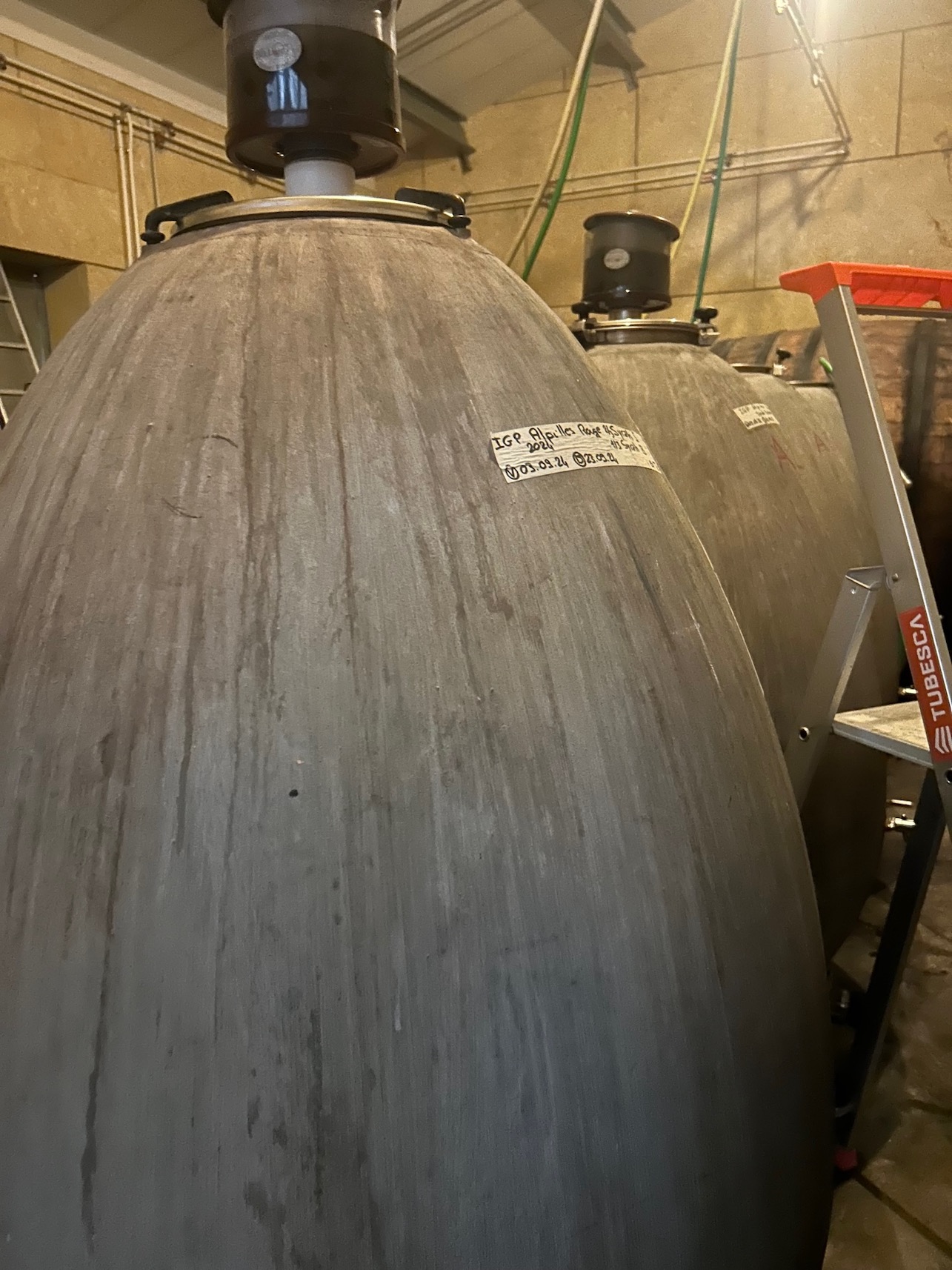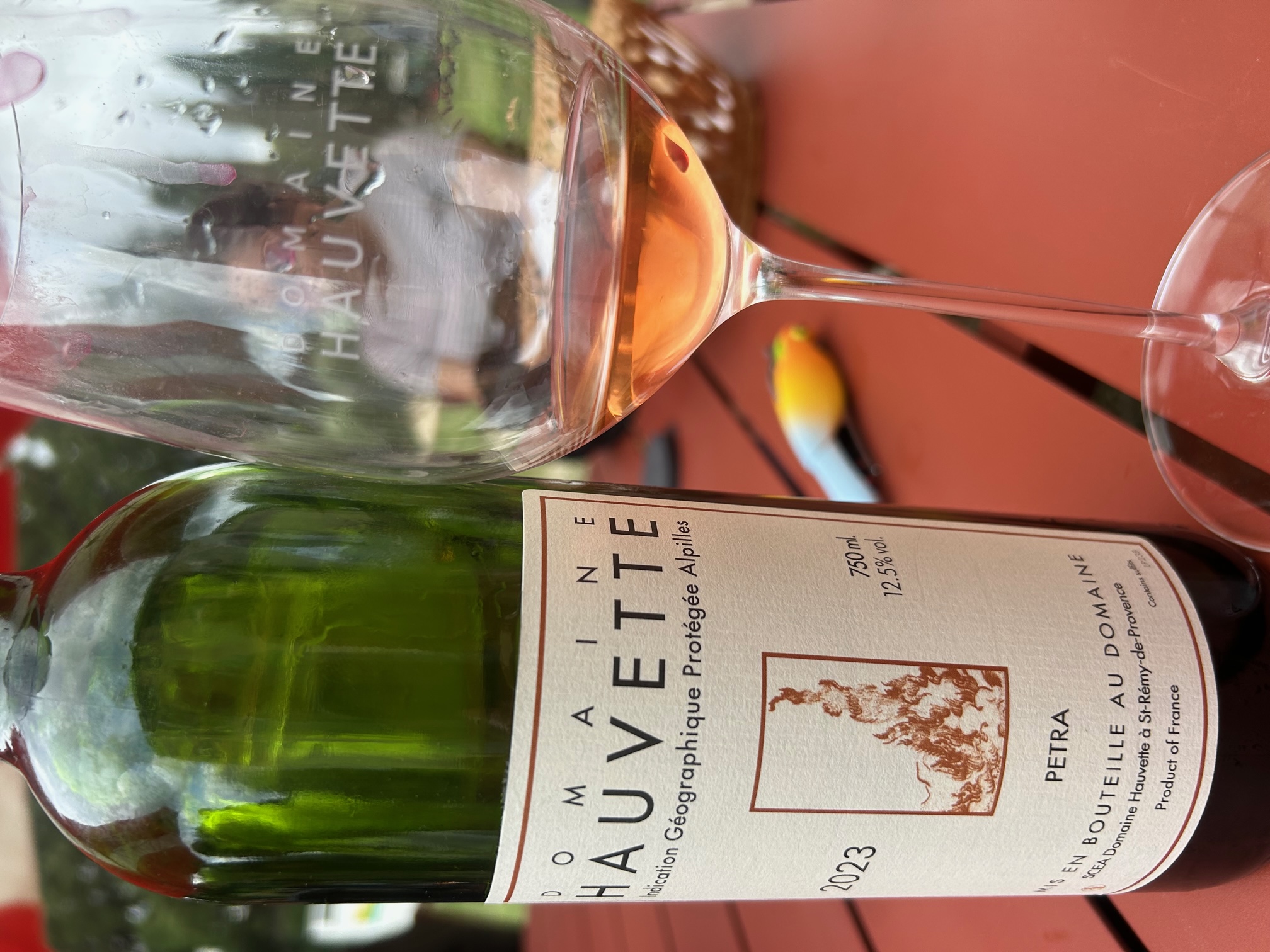Domaine Hauvette, Beau en Provence

Despite the best efforts of Marseille airport to stymy our arrival, we penetrated France’s Provençale perimeter, hired our fleet of jalopies, and set off on the road to Baux (one of the road movies that Crosby and Hope somehow neglected to make). After a couple of wrong turnings, we began to climb into the hinterland, eventually arriving at Domaine Hauvette, just north of the Massif des Alpilles and not far from Saint-Rémy-de-Provence, a tourist town known for Roman ruins and as the place where Van Gogh painted “The Starry Night.” Nestled among the foothills of Les Alpilles, the vines are surrounded by a rocky and wild landscape—the clay and limestone soil retains moisture for the arid summer months, the Mistral blows half the year, and garrigue is ubiquitous. It is in this location that in the early 1980s Dominique Hauvette, seeking more sunshine, left her job as a lawyer in the Savoie, re-discovered her passion for raising horses, began studying oenology and purchased a couple of hectares. Thirty-plus years later, Dominique now has 17 hectares of organic and biodynamically-farmed vines and has deservedly acquired an international reputation for making superbly elegant wines of all colours that speak profoundly of their origins.
As we entered the cellar, we saw trays with grapes being dried for a future passito wine. Inside the cellar a veritable mix of new and old. Dominique was one of the first vignerons to experiment with concrete eggs for fermentation and indeed there is a whole room hatching with them. There are also some mighty old foudres, some used barriques and tanks of all sizes. The watchwords of the winery are patience, discretion, and precision. We witnessed this in action when Dominique was racking a tank of red wine off the lees, using a headtorch as she peered into the wine, totally focused on the task in hand.
A word about concrete eggs
First commissioned in 2001 by Michel Chapoutier, concrete eggs are a modern innovation in winemaking based on much older principles. The shape of the egg is reminiscent of Roman amphorae, while concrete has been used in winemaking since the 19th Century.
The first egg was made by French vat manufacturer Marc Nomblot, who makes them from washed Loire sand, gravel, non-chlorinated spring water and cement. No chemicals or extra materials are added during manufacture. The unlined concrete is then treated with tartaric acid to prevent corrosion or any reactions with the wine during fermentation and ageing. Dominique emphasises the “naturalness” of these vessels.
Three reasons to go to wine work on an egg.
- Fermentation creates heat, which in turn creates convection currents that encourage the fermenting wine to move around. This occurs in fermentation vessels of all shapes and sizes but is most effective in an egg. The egg’s shape provides a smooth, continuous surface (without corners), which allows the wine to move more freely than it would in a traditional barrel or tank during fermentation. This constant movement allows complex flavours to develop through continuous contact with lees – much like batonnage.
- The thick concrete walls provide good insulation, keeping the temperature stable without the need for artificial cooling.
- Unlined concrete allows tiny amounts of oxygen to permeate and come into contact with the wine. This has the effect of softening tannins, creating a richer body and developing more complex flavours. A similar effect is achieved through barrel ageing, but concrete doesn’t impart the same oaky flavours of vanilla, spice and toast. In essence, a concrete egg allows the winemaker to retain a wine’s fruity characteristics, but without the reductive qualities of stainless steel; and add texture, but without the addition of oak flavours.
Well, I am convinced. And one cannot deny the aesthetic appeal of the egg. Since I was loitering near the back of the group fondling a nearby egg, as you do, I missed Dominique’s further explanation about the state of telluric forces and electromagnetic energy in her winery. Someone will enlighten me.
We returned outside to a table laid with an array of Hauvette wines, comprising three whites, a rosé, and two reds. Firstly, to say I am a sucker for Med whites. They tend to produce a style of wine not widely appreciated, subtle and textural by nature, rather than aromatic. Nor do these wines have the benefit of spinal acidity, relying instead on minerality, a herbal quality, and certain bitterness for their structural definition.
We begin, however, with the Hauvette rosé called Petra, a blend of Syrah, Cabernet Sauvignon and Grenache direct pressed into concrete eggs. With its brilliant lustre it is not a classic watery Provençale rosé. Delicate aromas of red fruits, small peaches and violets, and a smattering of crushed shells, this is a pure and pretty delight with an elevated palate. One of the best rosés I have ever tasted.
The first white we assayed was a Clairette from young vines, from pressed whole cluster grapes into stainless steel. This green-glinted white had a lovely frankness to it, with pithy green apple, grapefruit and stone fruit. Not complicated, but lovely.
Jaspe is pure Roussanne from a two-hectare plot of old vines, planted in limestone-heavy soils, pressed as whole bunches before fermentation in concrete eggs and a short maturation in stainless tanks. A beautiful expression of this grape with typical honeyed, white flower aromas, distinctive notes of golden orchard fruit before an intense palate shot through with flinty minerality, preserved lemon & stone fruit.
The Dolia Blanc is a third each of Roussanne, Marsanne, and Clairette (being a field blend from the same parcel harvested each year), whole cluster pressed, fermented and aged in cement eggs. This mineral-rich wine boasts an impeccable balance. Initially there is a mellow quality that permeates the palate, broadening with warmth and oxygen. The aroma of white flowers teases and the wines eases into a palate of beeswax, medicinal herbs, and apricot fruit that further enhances its complexity. A firm mineral core lends structure and power, delightfully accompanied by secondary notes of lanolin and wildflowers. It is a wine that moves at its own pace, reserved now, eloquent over time.
A relatively new wine to the Hauvette stable (word used advisedly given Dominique’s history in the equine department) is a Cinsault from young vines. This wine respects the delicacy of the variety with Dominique destemming and fermenting the grapes in wooden tanks for two to three weeks with light punchdowns, finally ageing the wine in stainless tanks. It is a joyously juicy little number with just enough stuffing.
Cornaline, named after the semi-precious stone, is a blend of Cab Sauv, Syrah and Grenache à la Trevallon. Its precise aromatics are packed with fragrant raspberries, wild cherries and strawberries. Very refined and savoury (think meat juices) on the palate with a medium body, dark smoky red fruits and a delightfully smooth, stony mineral zing. Limestone and garrigue mingle with sunshine-soaked fruit in a red wine to mull over. It is aged for several years before release which allows the wine to develop beautiful secondary aromatics and flavours.
It was an education to meet Dominique in a place that she evidently loves. Tasting the wines was also an education. Be they white or red, from young or old vines, they seemed to share the same sensibility, the same spirit. More than Provence, they were Hauvette.
*
Interested in finding out more about the wines of Domaine Hauvette? Contact us directly:
shop@lescaves.co.uk | sales@lescaves.co.uk | 01483 538820





